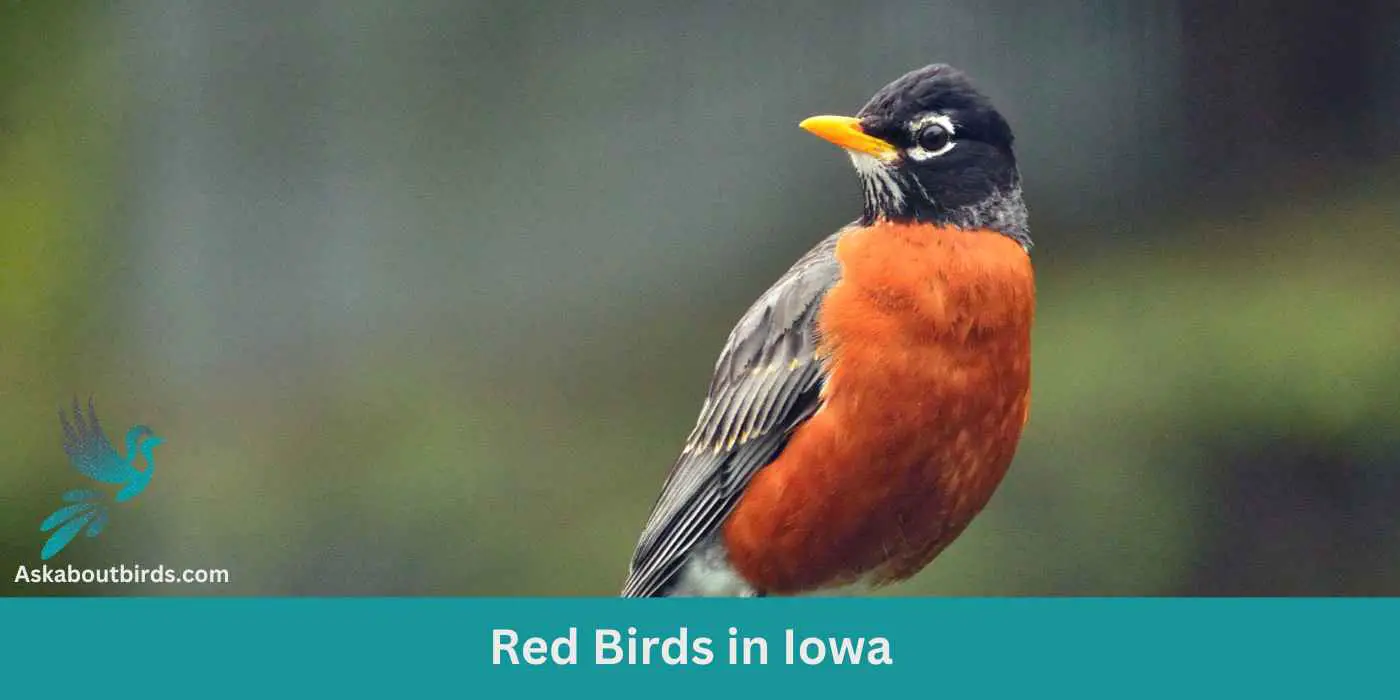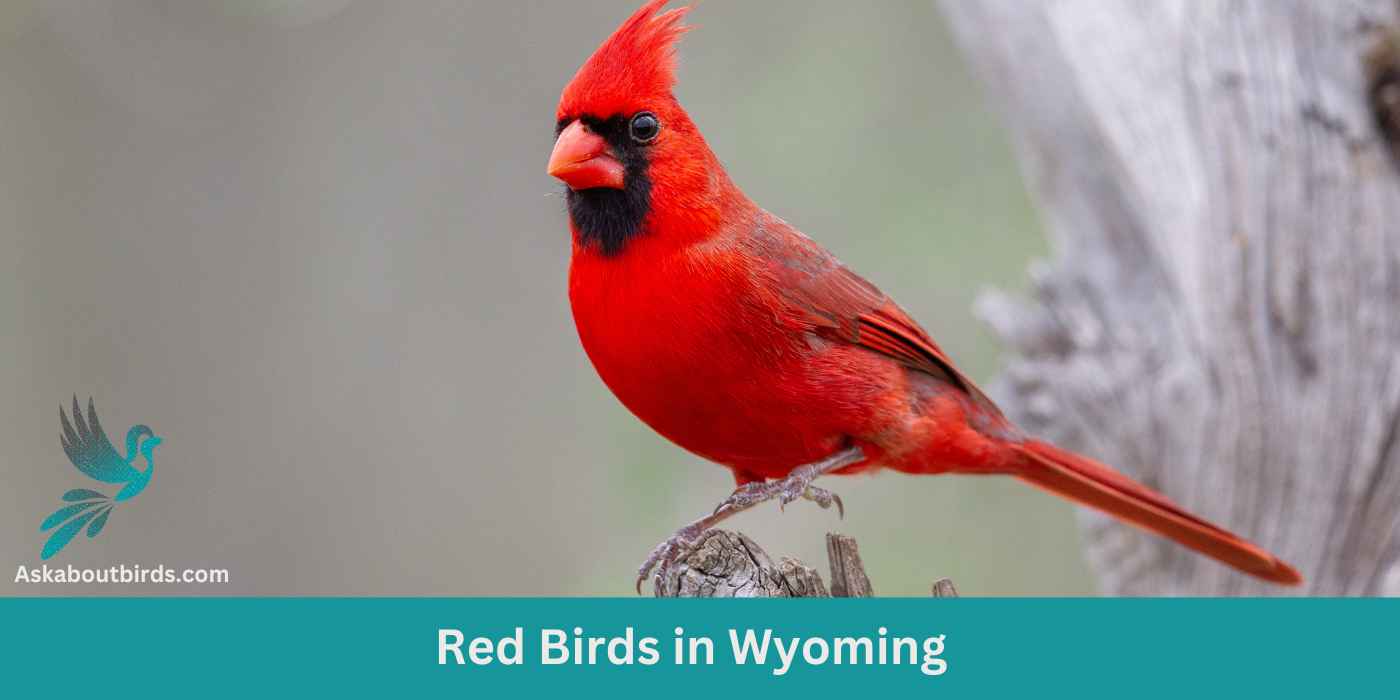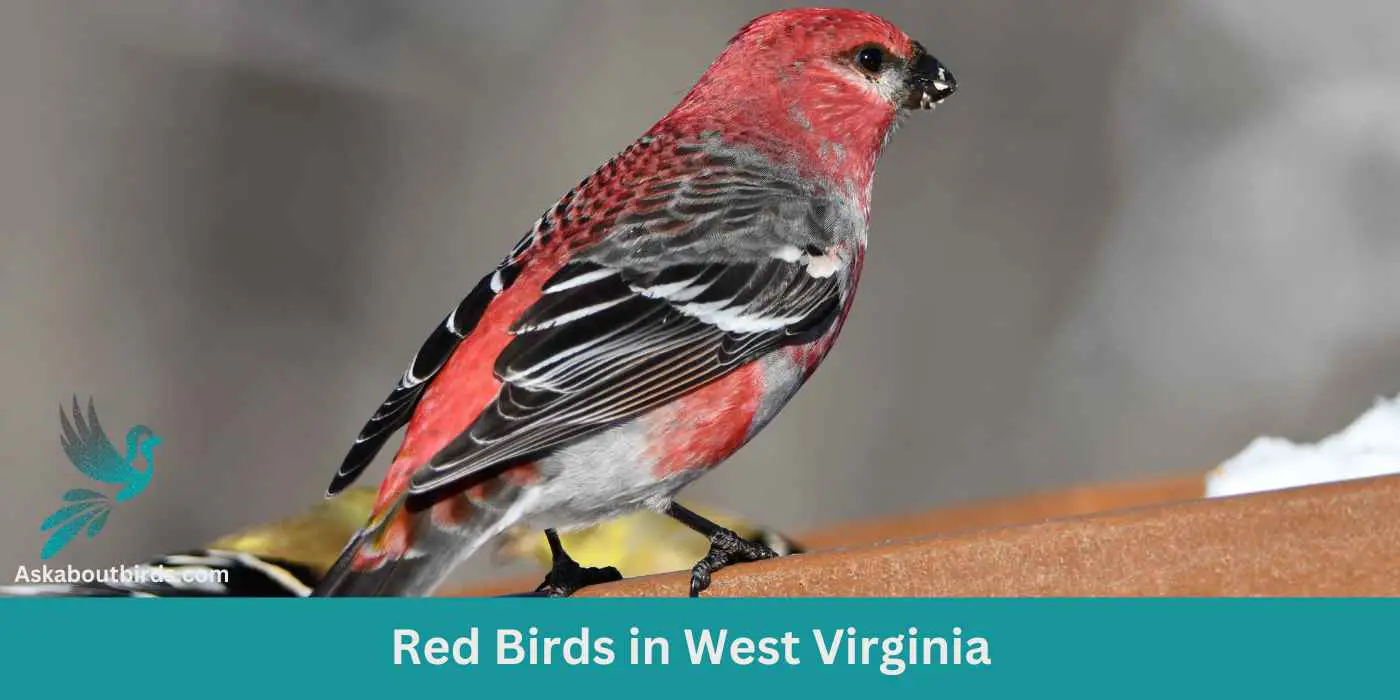Nestled in the heartland of America, Iowa’s rich tapestry of habitats serves as a canvas for a myriad of bird species, with a special spotlight on some truly radiant red avian wonders. From the rustling cornfields to serene wetlands, the state offers bird enthusiasts a visual treat of brilliant scarlet, deep maroons, and rosy hues.
In our guide, we unravel the mystery of these 9 red birds that call Iowa their home. Ready to soar with us?
Red Birds Found In Iowa
The vast expanse of Iowa’s grasslands, combined with its water bodies, creates a mosaic of habitats that attract a broad spectrum of bird species. This geographical setting, augmented by the state’s location within the Central Flyway, makes it a critical stopover for migratory birds.
Northern Cardinal


| Feature | Measurement |
|---|---|
| Scientific Name | Cardinalis cardinalis |
| Length | 8.3 – 9.1 in |
| Wingspan | 9.8 – 12.2 in |
| Weight | 1.19 – 2.29 oz |
The Northern Cardinal is an iconic North American bird, easily recognized by its vibrant color and melodious song.
Appearance: Male Northern Cardinals are a brilliant scarlet red, while females display a more subdued reddish olive. Both sexes have a distinctive black ‘mask’ on their face around the bill and a pointed crest on their head. The bird’s beak is robust, cone-shaped, and bright orange in color.
Diet: Northern Cardinals are primarily granivorous, with a diet largely consisting of seeds and grains. They also eat fruits and insects. These birds typically feed off the ground and are frequent visitors to bird feeders.
Reproduction: Northern Cardinals are monogamous, and a pair will breed together for life. The female typically builds a well-hidden nest in a dense thicket or shrub. She lays 2-5 eggs per clutch, which she incubates for around two weeks.
Summer Tanager


| Feature | Measurement |
|---|---|
| Scientific Name | Piranga rubra |
| Length | 6.7 in |
| Wingspan | 28 to 30 cm |
| Weight | 29 g |
The Summer Tanager is a medium-sized songbird admired for its radiant plumage and melodious song.
Appearance: Male Summer Tanagers are an impressive bright red, while females and juveniles present a softer, yellow-orange color. Both genders have a large, slightly hooked bill and relatively short tail.
Diet: Summer Tanagers primarily feed on insects, including bees and wasps, which they catch in flight or pick off vegetation. They are also known to eat fruits and berries, making them helpful in controlling pest populations and seed dispersal.
Reproduction: The female Summer Tanager builds a loose, shallow cup-shaped nest out of twigs and grass, usually hidden in the foliage of trees. The female typically lays 3-5 eggs, which she will incubate for about two weeks.
Scarlet Tanager


| Feature | Measurement |
|---|---|
| Scientific Name | Piranga olivacea |
| Length | 6.3 to 7.5 in |
| Wingspan | 9.8 to 11.8 in |
| Weight | 23.5 to 38 g |
The Scarlet Tanager is a strikingly colorful bird known for its brilliant plumage and distinctive song.
Appearance: Male Scarlet Tanagers are notable for their vibrant scarlet bodies contrasted with black wings and tail, making them one of the most intensely colored birds. Females and juveniles, on the other hand, have a subdued olive-yellow body color with darker wings and tail.
Diet: The diet of the Scarlet Tanager is largely made up of insects, including beetles, cicadas, aphids, and others. They are adept flycatchers, seizing insects in mid-air or picking them off foliage. They also consume fruits and berries, especially during migration and in their winter habitats.
Reproduction: The female Scarlet Tanager builds a cup-shaped nest using twigs, rootlets, and grass, typically well-hidden in the dense foliage of trees. She lays 3 to 5 eggs and incubates them for about two weeks.
Red-Winged Blackbird
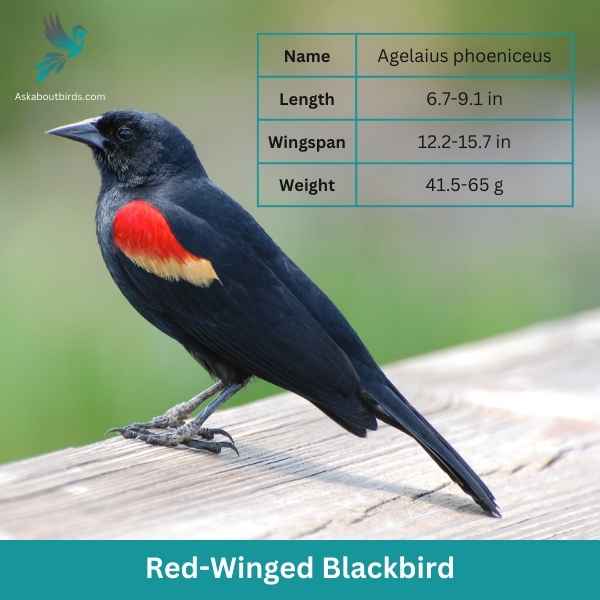
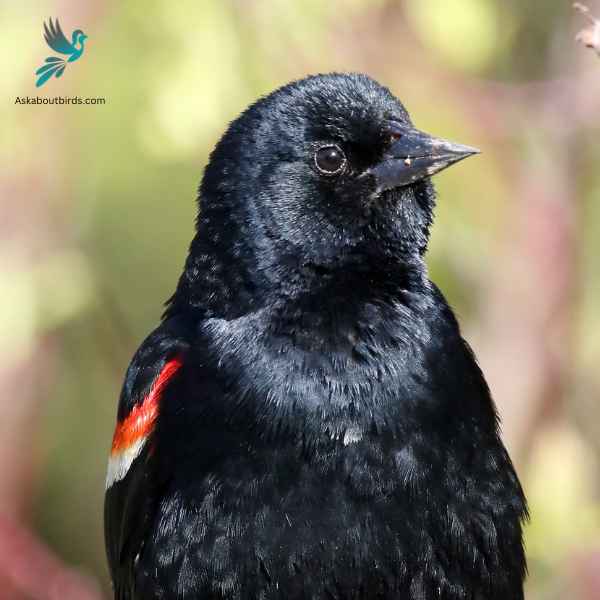
| Feature | Measurement |
|---|---|
| Scientific Name | Agelaius phoeniceus |
| Length | 6.7-9.1 in |
| Wingspan | 12.2-15.7 in |
| Weight | 41.5-65 g |
The Red-Winged Blackbird is a familiar sight across North America, especially in wetlands and open areas. Known for its striking coloration and distinct call, it is often seen perched on cattails or utility lines.
Appearance: Male Red-Winged Blackbirds are glossy black with bright red-and-yellow shoulder patches, while females are streaky brown, resembling a large sparrow. The males’ red patches become more prominent when they’re displaying or agitated.
Diet: Red-Winged Blackbirds primarily feed on seeds and insects. Their diet includes grains, sunflower seeds, and corn, but they also eat beetles, caterpillars, and other small invertebrates, especially in the breeding season.
Reproduction: Red-Winged Blackbirds nest in marshes, along watercourses, and in wet fields. The female constructs a cup-shaped nest using grass and sedge, attaching it to plants above water. She typically lays a clutch of 3 to 4 blue-green eggs, which she incubates for about 11-12 days. Males, being polygynous, often have multiple mates during a single breeding season.
House Finch


| Feature | Measurement |
|---|---|
| Scientific Name | Haemorhous mexicanus |
| Length | 5–6 in |
| Wingspan | 8–10 in |
| Weight | 0.6–0.9 oz |
The House Finch is a small songbird widely distributed across North America and is commonly found in urban and suburban areas.
Appearance: Males of this species are brightly colored with crimson faces and throats, which can extend to the chest and back, while their flanks have streaks. The female is streaked brown and lacks the red coloring. Both have a square-tipped tail and a distinctively long, flat-topped bill.
Diet: House Finches primarily eat seeds, grains, and berries. They have a particular fondness for sunflower seeds and can be commonly seen at bird feeders. Occasionally, they will also consume insects, especially during the breeding season.
Reproduction: House Finches are cavity-nesters and might choose ledges, vents, ledges, and other urban settings. They might also utilize trees or shrubs. Their nests can be made of a wide array of materials, from feathers to twigs.
Red-headed Woodpecker

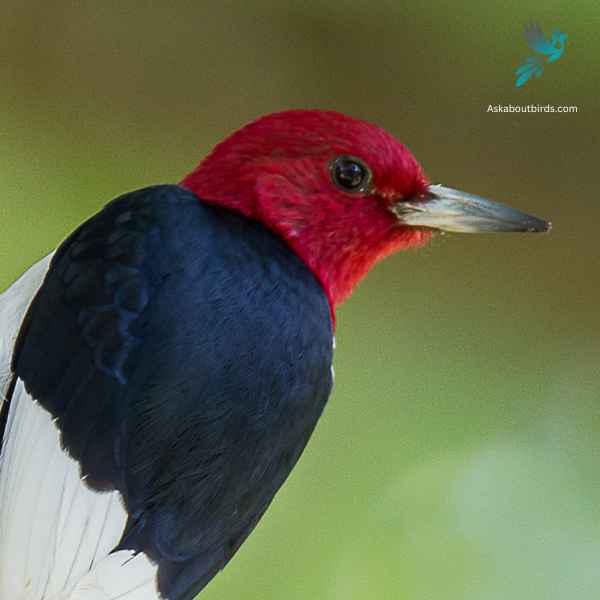
| Feature | Measurement |
|---|---|
| Scientific Name | Melanerpes erythrocephalus |
| Length | 7.5–9.1 in |
| Wingspan | 16.5 in |
| Weight | 2.0–3.2 oz |
The Red-headed Woodpecker is a striking forest bird with a bold tri-colored pattern.
Appearance: This woodpecker features a completely red head and neck, contrasting starkly with its white underparts and black wings. Its wings also have large white patches which are conspicuous in flight.
Diet: Red-headed Woodpeckers have a varied diet including insects, seeds, fruits, berries, and occasionally even the eggs of other birds. They’re also known to store food by wedging it into crevices in bark.
Reproduction: These woodpeckers nest in cavities which they excavate in dead wood or dead parts of live trees. These cavities can be found anywhere from 2 to 80 feet off the ground.
Red Crossbill

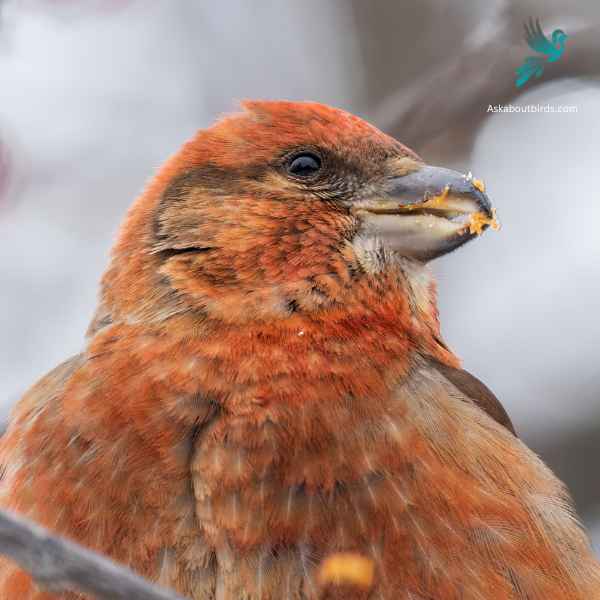
| Feature | Measurement |
|---|---|
| Scientific Name | Loxia curvirostra |
| Length | 5.5–7.5 in |
| Wingspan | 9.8–10.6 in |
| Weight | 0.9–1.4 oz |
The Red Crossbill is a distinctive finch known for its unusual bill, which has evolved to extract seeds from conifer cones.
Appearance: Males are typically bright red or orange, while females are greenish-yellow or olive. Both genders have the characteristic crossed bill, which they use to expertly extract seeds from tightly closed conifer cones.
Diet: Red Crossbills primarily feed on the seeds of coniferous trees, such as spruce, pine, and fir. Their specialized bills allow them to efficiently pry apart conifer cone scales to access the seeds.
Reproduction: Red Crossbills are somewhat nomadic and don’t adhere to a strict breeding schedule. Instead, they breed whenever and wherever food is abundant. Their nests are usually built on horizontal branches of conifer trees.
Pine Grosbeak

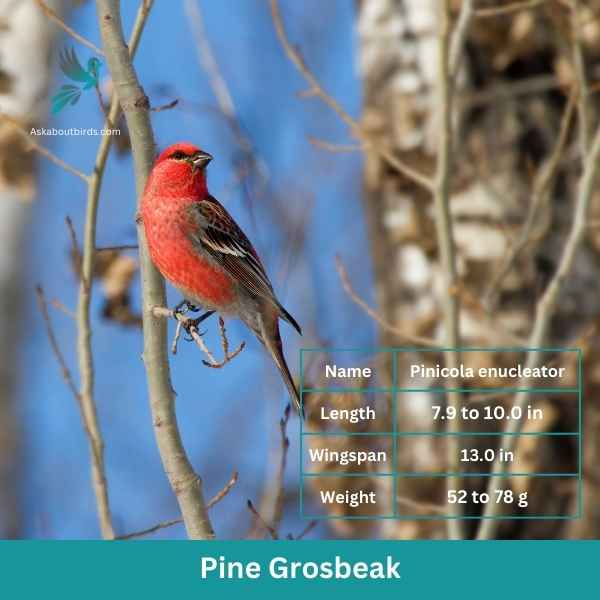
| Feature | Measurement |
|---|---|
| Scientific Name | Pinicola enucleator |
| Length | 7.9 to 10.0 in |
| Wingspan | 13.0 in |
| Weight | 52 to 78 g |
The Pine Grosbeak is a striking bird native to the northern regions of North America, often found in coniferous forests. Both males and females have a plump and robust body with a large beak adapted for eating seeds. The male Pine Grosbeak displays a vibrant reddish-pink plumage, while the female has a more subdued grayish-brown coloration.
These birds are typically seen in small flocks, foraging for food in trees and on the ground. They have a preference for seeds, particularly those from various conifer species. The Pine Grosbeak uses its strong bill to crack open the cones of tall trees and extract the seeds, but they also consume berries and small fruits when available.
American Robins


| Feature | Measurement |
|---|---|
| Scientific Name | Leptotila plumbeicep |
| Length | 10.6-11.8 in |
| Wingspan | — |
| Weight | 160-200 g |
The American Robin is a widely recognized bird species known for its melodious song and early bird tendencies.
Appearance: American Robins are medium-sized birds with a distinctive appearance. Both males and females sport a gray to brown back and a warm red to orange breast and belly and gray wings. They also have a characteristic white eye-ring and a black head, but males are usually darker than females.
Diet: American Robins have a diverse diet that changes depending on the season. In summer, they feed heavily on earthworms, beetles, and other invertebrates, which they catch on the ground. During winter, they mostly eat fruits and berries.
Reproduction: American Robins usually build their nests in trees or shrubs, but they are also known to nest on human-made structures. The female lays a clutch of about 3 to 5 eggs, which she incubates for about 12 to 14 days.
Where to Spot Iowa’s Red Birds
Exploring the Corn State of Iowa, with its expansive grasslands and water bodies, has provided a plethora of opportunities to observe its vibrant avian life, especially the stunning red birds. Here are some top spots that have proven to be bird-watching gems:
- Neal Smith National Wildlife Refuge: Situated near Prairie City, this refuge aims to restore the tallgrass prairie ecosystem. It’s a haven for grassland birds and offers sightings of various red bird species amidst its vast prairies.
- Ledges State Park: Located near Boone, this park features deep wooded valleys and high bluffs. The diverse habitat makes it a popular spot for a myriad of bird species, especially during migration periods.
- Mississippi River Flyway: Stretching along Iowa’s eastern border, the Mississippi River attracts countless migratory birds. The riverine habitats and adjoining woodlands are especially good for spotting vibrant red birds during various seasons.
- Rathbun Lake: One of Iowa’s largest lakes, Rathbun is surrounded by parks and wildlife areas, making it a hotspot for waterfowl and other bird species. Its diverse environment guarantees sightings of various avian wonders.
- Union Slough National Wildlife Refuge: Nestled in the north-central part of the state, this refuge is a vital wetland that provides shelter to waterfowl and other migratory birds. The rich mix of marshes, open water, and grasslands ensures a good diversity of bird species, including those with striking red plumages.
| State’s Red Birds | Best Spots to See Red Birds |
|---|---|
| Minnesota’s Red birds | 1. Agassiz National Wildlife Refuge 2. Tamarac National Wildlife Refuge 3. Sax-Zim Bog |
| Wisconsin’s Red birds | 1. Horicon Marsh National Wildlife Refuge 2. Chequamegon-Nicolet National Forest 3. Apostle Islands |
| Illinois’s Red birds | 1. Shawnee National Forest 2. Emiquon Preserve 3. Starved Rock State Park |
| Missouri’s Red birds | 1. Mingo National Wildlife Refuge 2. Ozark National Scenic Riverways 3. Mark Twain National Forest |
| Nebraska’s Red birds | 1. Crescent Lake National Wildlife Refuge 2. Niobrara National Scenic River 3. Rowewater Prairie |
| South Dakota’s Red birds | 1. Badlands National Park 2. Black Hills National Forest 3. Sand Lake National Wildlife Refuge |
FAQs on Red Bird Species Found in Iowa
Which red birds with bright red plumage are frequent visitors to backyard feeders in Iowa?
In Iowa, bird enthusiasts often spot the Rose Breasted Grosbeak and the more common House Finch at their backyard bird feeders. These birds, renowned for their bright red plumage, are particularly attracted to black oil sunflower seeds. The Rose Breasted Grosbeak, distinguished by its white wing bars and pale bill, is a delight for bird watchers, while the House Finch, with its heavily streaked brown plumage, is a common backyard bird.
Are there any red birds in Iowa that primarily eat insects?
Yes, the Ruby Throated Hummingbird and the Male Scarlet Tanager are red birds commonly found in Iowa’s oak trees and oak savannah regions. They are known to feast on flying insects. The Ruby Throated Hummingbird, while small, stands out with its dark green back and bright red throat, darting swiftly in the forest canopy to catch its prey. The Male Scarlet Tanager, with its vibrant plumage, forages both in the forest canopy and on the forest floor.
Which red birds with white wing bars can bird enthusiasts spot in the forest edges and deciduous woods of Iowa?
Bird enthusiasts in Iowa can look out for the Purple Finch and the White Winged Crossbills in the forest edges and deciduous woods. Both these birds have distinctive white wing bars. Purple Finches, contrasting their names, have a deep reddish hue and often visit backyard feeders. On the other hand, White Winged Crossbills are known for their unique bill shape, feeding primarily on conifer seeds.
Are Northern Flickers common red birds in Iowa’s woodland edges?
Yes, Northern Flickers are common birds in Iowa’s woodland edges and oak savannah regions. These woodpeckers, identifiable by their dark wings and a flash of red on the nape, are year-round residents of the state. They primarily forage on the ground, feeding on ants and beetles, and are often seen by bird watchers and common bird enthusiasts alike.

